- Home
- »
- Automotive & Transportation
- »
-
Rolling Stock Market Size, Share & Growth Report, 2030GVR Report cover
![Rolling Stock Market Size, Share & Trends Report]()
Rolling Stock Market Size, Share & Trends Analysis Report By Product (Locomotive, Rapid Transit Vehicle, Wagon), By Type, By Train Type, By Region, And Segment Forecasts, 2024 - 2030
- Report ID: GVR-2-68038-322-5
- Number of Report Pages: 120
- Format: PDF, Horizon Databook
- Historical Range: 2018 - 2022
- Forecast Period: 2024 - 2030
- Industry: Technology
Rolling Stock Market Size & Trends
The global rolling stock market size was estimated at USD 64.10 billion in 2023 and is projected to grow at a compound annual growth rate (CAGR) of 6.3% from 2024 to 2030. Increasing investments in the railway infrastructure and the growing adoption of advanced digital solutions are key factors driving the rolling stock market growth. Rolling stock vehicles, including locomotives, freights, wagons, and rapid transit vehicles play a major role in facilitating reliable, comfortable, and cost-effective transportation for passengers and transporting goods across long distances.
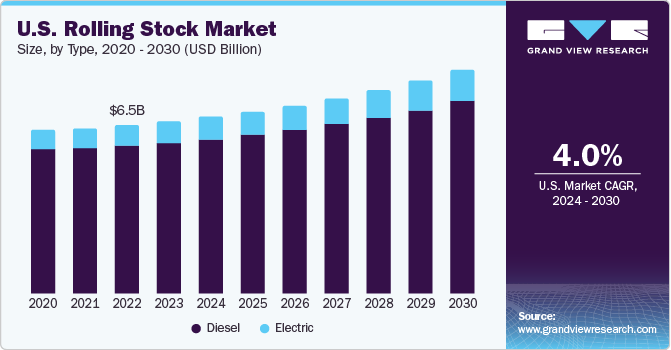
Several government agencies and private entities are focusing on enhancing their transportation infrastructure while deploying a large number of rolling stock vehicles that can carry considerable loads of freight, ultimately contributing to market growth. For instance, as per Global Railway Review, as of January 2023, the Indian railways contribute approximately 27% of India’s freight transport. Thus, the government of India is aiming to enhance the current share of railway freight transport to almost 40 - 45% in the coming years. As a result, the government is focusing on various strategic initiatives, including collaborations and partnerships with the major players in the rolling stock industry, to be undertaken in order to achieve its target. These initiatives involve high investments in the deployment of advanced rolling stock vehicles and advancements in the associated railway infrastructure.
Increasing investments in railway infrastructure are significantly impacting the rolling stock market growth. With increased investments in railway infrastructure, the focus on modernizing rolling stock is increasing. This involves upgrading locomotives with more powerful engines, installing better braking systems, and improving passenger comfort in coaches. Furthermore, it includes the use of environmentally friendly rolling stock, such as electric trains or trains powered by alternative fuels. Increased investments in railway infrastructure also lead to the expansion of railway networks, which can subsequently drive the demand for rolling stock.
This involves the purchase of new locomotives, coaches, and wagons to meet the needs of an expanded network. Infrastructure upgrades such as improvements to the tracks, which include reducing the number of curves or installing modern signaling systems, are also contributing to the market growth. For instance, in March 2023, Siemens announced an investment of USD 220 million to build advanced manufacturing and rail services facilities in North Carolina, U.S. These new facilities are expected to improve rail technology to aid passenger’s smooth journey within the country.
Advances in technology have made it possible to design and produce energy-efficient rolling stock. For instance, modern electric locomotives use regenerative braking, which captures the energy lost during braking and stores it in onboard batteries. This energy can be used later to power the train, which reduces the overall energy consumption and costs. New technologies such as computer vision, and artificial intelligence are also making rail transportation safer. These technologies can be used to detect obstacles on the tracks, monitor train performance, and prevent collisions. For instance, Positive Train Control (PTC) technology uses GPS, wireless communication, and onboard computers to slow down or stop trains and prevent accidents automatically.
The increased preference for railway transportation has resulted in considerable demand for this rolling stock and supporting infrastructure in recent years. However, the high cost of trains, rolling equipment, and accompanying infrastructure are capital-intensive and require considerable financial support from local and central administrations. Therefore, several rolling stock OEMs, rail operators, and third-party suppliers are shifting their focus to condition-based maintenance procedures conducted in real-time while trains are in operation. The near-time analytics programs assist authorities in conducting rail maintenance. By following these procedures, the rolling stock OEMs are observed to reduce their maintenance costs up to USD 2 billion annually.
Besides, several major reforms are underway in the railway sector. New features will be added to trains and the infrastructure on all routes. For instance, in March 2023, the KONCAR - ElektriCna vozila dd, introduced an electric-diesel train at Pula Railway Station. The train can travel at a speed of 120 km/h and has a capacity of 167 passengers. It is a low-floor, three-part train with four double doors on each side. It contains two ramps for wheelchairs, space for bicycles, and video surveillance across the entire passenger area. Passengers receive free Wi-Fi and visual and auditory announcements at stations and stops. This factor is expected to enhance the quality of the transport service, as this type of low-floor train will cover 50% of the lines in this area.
Market Concentration & Characteristics
Market is registering a medium growth stage and pace of the market growth is accelerating. The rolling stock market is characterized by a high degree of innovation. The railway industry is digitizing continuously by adopting IoT and big data analytics and rolling out sensor networks to facilitate predictive maintenance and real-time monitoring of train operations, and subsequently, improve the safety and security of rolling stock.
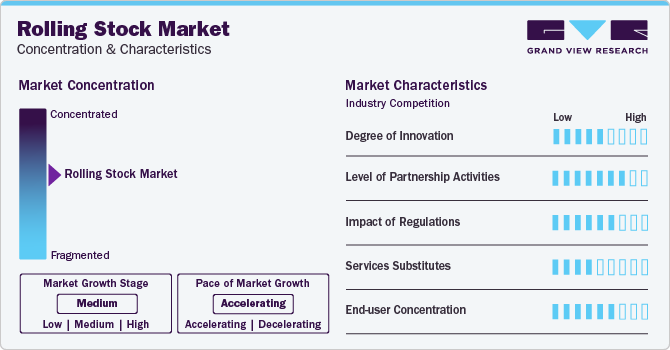
The rolling stock market is also characterized by a high level of partnership activity by the market players. Players adopt this strategy to increase the reach of their products in the market and increase the availability of their products & services in diverse geographical areas.
Both governments and industry regulators are focusing on ensuring the safety of rolling stock on various parameters, including crashworthiness, fire safety, and compliance with signaling and train control systems. There are growing concerns over the environmental impact, particularly the greenhouse gas emissions associated with the rolling stock. Hence, regulations are being drafted to encourage the use of more energy-efficient and low-emission rolling stock.
Road transportation and air transportation can be considered direct substitutes for rail transportation, and access to these modes of transportation is easing gradually as governments are investing aggressively in infrastructure development. However, rail transportation remains the most cost-efficient and environment-friendly mode of transportation. Hence, the threat of substitutes can be considered moderate.
The end-users of rolling stock include railroad companies, repair & leasing companies, governments, and private operators. The government uses rolling stock for the carriage of goods and passengers. Rolling stock is a part of public transport that is operated by governments in countries such as India, whereas, in developed countries such as the U.S. and Germany, it is operated by private entities. In addition, it is widely used for the transportation of goods such as agricultural products, conventional fuels, construction materials, heavy machinery, and others.
Product Type Insights
The wagons segment led the market and held 34.1% of the total revenue share in 2023. Factors such as high speed, affordability, and comfortable travel make it the preferred choice of public transport by the increasing urban population. Moreover, increasing investments by key players in automating and digitalizing the components associated with wagons is further attributed to drive the market growth. Governments and private players prefer to use wagons for the movement of goods domestically or internationally due to their ability to carry high-volume loads. Wagons are economical and reliable for short and long transit. Governments and private players worldwide are either investing in buying new fleets of wagons or refurbishing their existing fleets.
The rapid transit vehicle segment is expected to register the highest growth rate over the forecast period. Increasing urbanization leading to expanding cities and towns is further anticipated to create growth opportunities for manufacturers. Moreover, rising urbanization is also compelling government authorities to launch public transport projects for rapid transit vehicles, such as metros and passenger rails, leading to increased investment in rapid transit rolling stock and its infrastructure.
Type Insights
The diesel segment held the largest market revenue share in 2023. Factors such as low cost, easy availability, and lesser volatility of diesel engines contribute to the growth of the segment. Moreover, the growing need for enhancing freight transport and low replacement rate of diesel to electric has allowed this segment to drive the rolling stock market growth. Also, several major manufacturers are developing turbocharged diesel vehicles to cater to the increasing demand for efficient diesel-powered vehicles. Due to their ability to haul freight trains carrying heavy goods. They are widely used for industrial purposes due to higher torque engines. However, as the world becomes more environment-conscious, diesel trains technology is advancing to develop low-emission engines for diesel locomotives.
The electric-based rolling stock segment is expected to grow considerably over the forecast period. Increasing awareness regarding environmental pollution is further encouraging the use of electric vehicles for transportation. Countries are expanding electric rolling stock production and service centers as a result of collaboration between governments and manufacturers. For instance, in December 2022, Alstom partnered with the government of Kazakhstan to increase the production of local rolling stock. As part of the agreement, technology transfer and the production of electric locomotives and components were highlighted. The company invested approximately USD 53 million to build new workshops for bogie and electrical cabinets, as well as service centers and maintenance depots.
Train Type Insights
Rail freight segment led the market share in 2023. Considered to be an integral part of the worldwide supply chain, its ability to transport high-volume goods internationally and domestically positions them as preferred alternative to road transport. The digitalization of freight offers rail operators significant opportunities in terms of operating safety and productivity, improving their professional attractiveness and working conditions. For instance, in February 2023, the members of the French Rail Freight of the Future (4F) coalition launched the MONITOR project. The project involved equipping rail cars with sensors that detect derailments and incorrect brake applications, reducing time spent preparing trains.
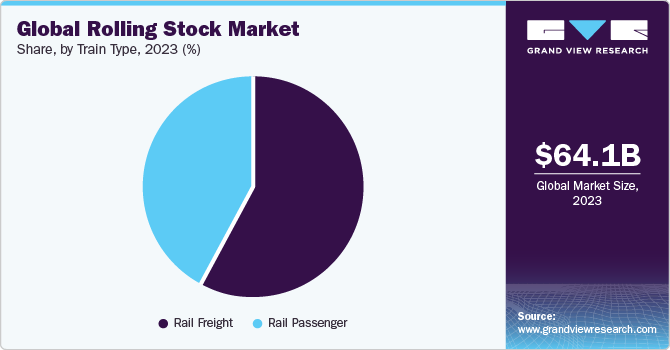
The rail passenger segment is anticipated to grow significantly over the forecast period. The growth of the passenger rail segment is attributed to the increasing demand for public rail transportation. Passengers are preferring this type of transportation owing to several benefits, such as reliability, comfort, and reduced traffic compared to road transportation. Various companies are manufacturing passenger rail vehicles with the latest technologies to improve the passenger experience and enhance security.
Regional Insights
Asia Pacific dominated the rolling stock market and held the largest revenue share of 43% in 2023. Emerging economies such as China and Taiwan are continuously investing in advanced trains to improve their respective transportation services. Moreover, manufacturers in the region are supporting initiatives undertaken by their respective governments to upgrade transportation systems. The rising demand has prompted governments to implement trams and adopt electric locomotives on a large scale. Such initiatives also enable the countries to achieve economies of scale with their existing railway infrastructure.
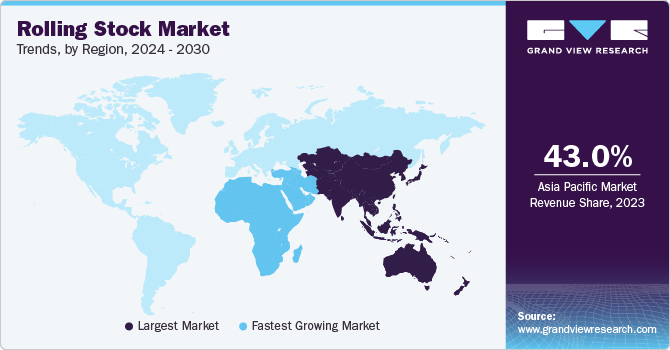
MEA region is expected to register the highest growth rate over the forecast period. The oil and gas industry is the largest user of rolling stock in the Middle East. Tank wagons are the most commonly used rail vehicles in the oil and gas industry for transporting oil. Furthermore, benefits such as reliability, safety, and cost-efficiency are expected to encourage the region to adopt rolling stock for the transportation of goods. The demand for electric locomotives and locomotives fitted with turbochargers is expected to grow significantly as a result of the rising demand for energy-efficient rail vehicles. The automation of railway systems and convergence of different technologies to achieve automation would also gain traction over the forecast period.
Key Rolling Stock Company Insights
Some of the key players operating in the market include CRRC Corporation Limited, Bombardier, Siemens Mobility, Alstom, and GE Transportation.
-
CRRC Corporation Limited is engaged in the manufacturing of rolling stock products, such as electric locomotives, diesel locomotives, high-speed trains, Diesel Multiple Units (DMUs), Electric Multiple Units (EMUs), metro cars, Light Rail Vehicles (LRVs), coaches, and wagons. Its products and services offer several benefits, such as energy efficiency, eco-friendliness, and cost efficiency.
-
Siemens Mobility is primarily involved in the manufacturing of rolling stock and locomotive products. The company provides rail vehicles such as metros, trams & light rail, automated people mover, and locomotives.
Trinity Industries, Inc., Kawasaki Heavy Industries, Ltd., Stadler Fahrzeuge AG, Hyundai Motor Group, and Westinghouse Air Brake Technologies Corporation are some of the emerging market participants in the forklift market.
-
Trinity Industries, Inc. is a rail car manufacturing company that caters to a wide range of rail cars, such as hoppers, flat cars, gondolas, open hoppers, boxcars, and tank cars. The company also provides operating leases & financial services and railcar management & administrative services.
-
Hyundai Motor Group is a manufacturer of rail equipment and vehicles for various fields, such as logistics, government, and repair & leasing companies. Its product offerings include electric multiple units, diesel multiple units, high-speed trains, light rail vehicles, magnetically levitated vehicles, trams, locomotives, and passenger coaches.
Key Rolling Stock Companies:
The following are the leading companies in the rolling stock market. These companies collectively hold the largest market share and dictate industry trends. Financials, strategy maps & products of these rolling stock companies are analyzed to map the supply network.
- Alstom Transport
- CRRC Corporation Limited
- GE Transportation
- Hitachi Rail System
- Hyundai Rotem
- Kawasaki Heavy Industries, Ltd.
- Siemens Mobility
- Stadler Rail AG
- The Greenbrier Co.
- Trinity Rail
Recent Developments
-
In February 2023, Stadler Rail AG partnered with ASPIRE Engineering Research Centre and the Utah State University, for the construction of a passenger train powered by batteries centered on the FLIRT Akku idea. The development, construction, and testing of a FLIRT Akku battery-operated two-car multi-unit are all included in the project's scope. During subsequent test runs, the trio will focus on delivering insights for American passenger transit decarburization using battery-powered trains.
-
In February 2023, Stadler Rail AG announced the acquisition of BBR Verkehrstechnik GmbH, a railroad company, and its group businesses to increase its internal expertise in the digitalization and signaling technology fields. By joining forces, the companies will be able to offer advanced signaling solutions that will enhance and shape the digitization of the rail industry.
-
In January 2023, Siemens Mobility partnered with the Indian Railways, wherein it received a purchase order for 1,200 locomotives with 9,000 HP, making it the single largest locomotive order in the history of Siemens Mobility and Siemens India. The trains will be designed, developed, assembled, and put through testing by Siemens Mobility. The contract covers 35 years of full-service maintenance, and the deliveries are scheduled over an 11-year period. The trains will be assembled at the Indian Railways facility in Gujarat, India.
-
In November 2022, Siemens Mobility announced the construction of a train bogies factory in Aurangabad, India. The new plant can fill a single export order with more than 200 bogies. These rail bogies were produced by Siemens using the SF30 Combino Plus global design idea. The factory has a flexible manufacturing facility to meet domestic and overseas rolling stock demand. It can produce bogies for locomotives, coaches, trams, metros, and various electric vehicles.
Rolling Stock Market Report Scope
Report Attribute
Details
Market size value in 2024
USD 67.12 billion
Revenue forecast in 2030
USD 96.58 billion
Growth rate
CAGR of 6.3% from 2024 to 2030
Base year for estimation
2023
Historical data
2018 - 2022
Forecast period
2024 - 2030
Report updated
February 2024
Quantitative units
Revenue in USD million/billion and CAGR from 2024 to 2030
Report coverage
Revenue forecast, company ranking, competitive landscape, growth factors, and trends
Segments covered
Product, type, train type, region
Regional scope
North America; Europe; Asia Pacific; Latin America; MEA
Country scope
U.S.; Canada; U.K.; Germany; France Italy; Russia; China; India; Japan; South Korea; Australia; Brazil; Mexico; Argentina; UAE; Saudi Arabia; South Africa
Key companies profiled
CRRC Corporation; Trinity Rail; Alstom Transport; GE Transportation; Siemens Mobility; Stadler Rail AG; Hitachi Rail System; The Greenbrier Co.; Hyundai Rotem; Kawasaki Heavy Industries, Ltd.
Customization scope
Free report customization (equivalent to up to 8 analysts working days) with purchase. Addition or alteration to country, regional & segment scope.
Pricing and purchase options
Avail customized purchase options to meet your exact research needs. Explore purchase options
Global Rolling Stock Market Report Segmentation
This report forecasts revenue growth at global and regional levels and analyzes the industry trends in each of the sub-segments from 2018 to 2030. For this study, Grand View Research has segmented the global rolling stock report based on product, type, train type, and region:
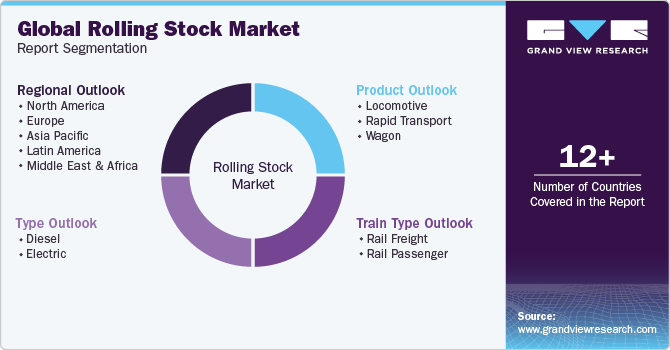
-
Product Outlook (Revenue, USD Million, 2018 - 2030)
-
Locomotive
-
Rapid Transport
-
Wagon
-
-
Type Outlook (Revenue, USD Million, 2018 - 2030)
-
Diesel
-
Electric
-
-
Train Type Outlook (Revenue, USD Million, 2018 - 2030)
-
Rail Freight
-
Rail Passenger
-
-
Region Outlook (Revenue, USD Million, 2018 - 2030)
-
North America
-
U.S
- Canada
-
-
Europe
-
U.K.
-
Germany
-
France
-
Italy
-
-
Asia Pacific
-
China
-
Japan
-
India
-
Australia
-
South Korea
-
-
Latin America
-
Brazil
-
Mexico
-
Argentina
-
-
Middle East and Africa
-
UAE
-
Saudi Arabia
-
South Africa
-
-
Frequently Asked Questions About This Report
b. The global rolling stock market size was estimated at USD 64.10 billion in 2023 and is expected to reach USD 67.12 billion in 2024.
b. The global rolling stock market is expected to witness a compound annual growth rate of 6.3% from 2024 to 2030 to reach USD 96.58 billion by 2030.
b. Asia Pacific region held the largest share of 43.0% in 2023 owing to the large-scale adoption of rail vehicles for transporting passengers and goods. Moreover, the growth of the regional market can also be attributed to the increase in investments in metro and electric trains in countries such as China, India, Taiwan, and others.
b. Some key players operating in the rolling stock market include CRRC Corporation Limited, Bombardier Transportation, Alstom Transport, GE Transportation, Trinity Rail Group, LLC, Siemens Mobility, Stadler Rail AG, Hitachi Rail Systems, The Greenbrier Co, and Hyundai Rotem.
b. The key factors driving the growth of the rolling stock market include the growing concertation of the population in urban areas and the increasing demand for rail vehicles such as trams, local trains, passenger rails, and so on. Moreover, the rising preference for high-speed trains over conventional trains owing to faster transportation and comfortability is likely to further boost the market growth over the forecast period.
Share this report with your colleague or friend.
![gvr icn]()
NEED A CUSTOM REPORT?
We can customize every report - free of charge - including purchasing stand-alone sections or country-level reports, as well as offer affordable discounts for start-ups & universities. Contact us now
![Certified Icon]()
We are GDPR and CCPA compliant! Your transaction & personal information is safe and secure. For more details, please read our privacy policy.
We are committed towards customer satisfaction, and quality service.
"The quality of research they have done for us has been excellent."





